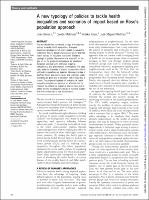| dc.description.abstract | The last decade has witnessed a surge in interest for policies to tackle health inequalities. Adequate theoretical development of policy models is needed to understand how to design and evaluate equity-oriented health policies. In this paper we review Graham’s typology of policies (focused on the worst-off, on the gap, or on the gradient) and propose an adaptation (targeted, universal with additional targeting, redistributive, and proportionate universalism). For each type, potential scenarios of impact on population health and health inequalities are depicted following the idea of Geoffrey Rose’s population curves and strategies, policy examples are given and a simulation with survey data is shown. The proposed typology of scenarios of health inequality reduction can serve as an effective tool to interpret the differential impact of interventions and to reflect on how to adequately design or re-orient a policy and which measures to use to evaluate it. | |

